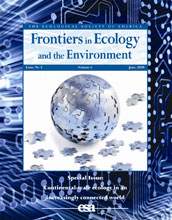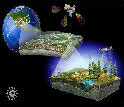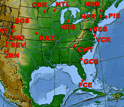|

Press Release 08-089
Large-Scale Experiments Needed to Predict Global Change

New look at ecosystem connections through long-term research
June 1, 2008
Ecosystems are constantly exchanging materials through the movement of air in the atmosphere and water in lakes and rivers. The effects of humans, however, are another major source of connections among ecosystems. In a special issue of the journal Frontiers in Ecology and the Environment on "Continental-scale ecology in an increasingly connected world" (June 2008), ecologists discuss how human influences interact with natural processes to influence global connectivity. The authors conclude that networks of large-scale experiments are needed to predict long-term ecological change. "We know that the world has always been connected via a common atmosphere and the movement of water," says Debra Peters, an author in the issue and a scientist with the Agricultural Research Service at the U.S. Department of Agriculture (USDA-ARS). "The world is also becoming highly interconnected through the movement of people and the transport of goods locally to globally," says Peters. "Ecologists are increasingly realizing that these links can have profound influences on the long-term dynamics of ecological systems." The transport of many types of materials, including gases, minerals and even organisms, can affect natural systems. This movement results in "greenlash," which occurs when environmental changes localized to a small geographic area have far-reaching effects in other areas. For example, a drought in the 1930s increased soil erosion across the farmlands of the U.S. Midwest, leading to intense dust storms. Large amounts of wind-swept dust traveled across the continent, causing the infamous Dust Bowl and affecting air quality, public health and patterns of human settlement throughout the country. Because of increasing globalization, people often inadvertently introduce non-native plants, animals and diseases into new locations. Invasive species and pathogens, such as fire ants from South America and West Nile virus from Africa, can create large, expensive problems: the U.S. currently spends more than $120 billion per year on measures to prevent and eradicate invasive species. Understanding ecosystem connectivity across a range of scales--from local to regional to continental--will help scientists predict where invasive species are likely to go next. The authors agree that field ecology studies should focus on long-term sampling networks that encompass a range of geographical scales. Integrating data from existing and developing networks, such as the National Science Foundation (NSF)'s Long-Term Ecological Research (LTER) network and NSF's National Ecological Observatory Network (NEON), will lead to a level of ecological comparison unparalleled by any one experiment. "Understanding the biosphere in an increasingly connected world requires a new way of looking at living systems," says Elizabeth Blood, program director for NEON. "The research, infrastructure and technology discussed in this special journal issue will expand our horizons and allow us to better view ecology on a large-scale." "To draw conclusions about the consequences of increasing connectivity, we need to provide information about processes that span a vast scale of space and time," says David Schimel, an author in the issue and chief executive officer of the NEON project. "Our observations will characterize ecological processes from the genomic to the continental, and document changes from seconds to decades." The authors also suggest that long-term studies should include data from the social and behavioral sciences. Ecologists hope that understanding the patterns of connectivity within and among ecosystems will lead to more accurate predictions of future ecological change, the authors write. "Building links among research sites and networks takes a commitment of time and resources," says Henry Gholz, program director for LTER. "The articles in this issue describe an effort to build those links in the scientific community. They will enable large-scale research into the important and complex ecological issues facing society today." Ecologists hope that understanding the patterns of connectivity within and among ecosystems will lead to more accurate predictions of future ecological change. "For example, the addition of coastal and oceanic LTER sites has increased our knowledge of the relationships between terrestrial and marine processes," says David Garrison, NSF program director for biological oceanography. "This knowledge will help us better understand the effects of environmental change on near-shore ecosystems." The special issue of Frontiers was supported by funding from NSF, the USDA-ARS and the Consortium for Regional Ecological Observatories.
-NSF-

Media Contacts
Cheryl Dybas, NSF (703) 292-7734 cdybas@nsf.gov
Christine Buckley, Frontiers in Ecology and the Environment (202) 833-8773 christine@esa.org
Program Contacts
Elizabeth Blood, NSF: National Ecological Observatory Network (NEON) (703) 292-8480 eblood@nsf.gov
Henry Gholz, NSF: Long-Term Ecological Research (LTER) Network (703) 292-8480 hgholz@nsf.gov
David Garrison, NSF: Coastal/Ocean Long-Term Ecological Research (LTER) Sites (703) 292-8580 dgarriso@nsf.gov
Related Websites
Frontiers in Ecology and the Environment: http://www.frontiersinecology.org/
NSF National Ecological Observatory Network: http://www.neoninc.org
NSF Long-Term Ecological Research Program: http://www.lternet.edu

The National Science Foundation (NSF) is an independent federal agency that
supports fundamental research and education across all fields of science and
engineering, with an annual budget of $6.06 billion. NSF funds reach all 50
states through grants to over 1,900 universities and institutions. Each year,
NSF receives about 45,000 competitive requests for funding, and makes over
11,500 new funding awards. NSF also awards over $400 million in
professional and service contracts yearly.
 Get News Updates by Email Get News Updates by Email
Useful NSF Web Sites:
NSF Home Page: http://www.nsf.gov
NSF News: http://www.nsf.gov/news/
For the News Media: http://www.nsf.gov/news/newsroom.jsp
Science and Engineering Statistics: http://www.nsf.gov/statistics/
Awards Searches: http://www.nsf.gov/awardsearch/
| 




